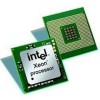Intel X5472 Specification Update - Page 38
B0-B3 Bits in DR6 For Non-Enabled Breakpoints May be Incorrectly Set
 |
UPC - 735858201551
View all Intel X5472 manuals
Add to My Manuals
Save this manual to your list of manuals |
Page 38 highlights
Implication: Execution of the stores in XSAVE, when XSAVE is used to store SSE context only, may not follow program order and may execute before older stores. Intel has not observed this erratum with any commercially available software. Workaround: None identified. Status: For the steppings affected, see the Summary Tables of Changes. AX70. Problem: Memory Ordering Violation With Stores/Loads Crossing a Cacheline Boundary When two logical processors are accessing the same data that is crossing a cacheline boundary without serialization, with a specific set of processor internal conditions, it is possible to have an ordering violation between memory store and load operations. Implication: Due to this erratum, proper load store ordering may not be followed when multiple logical processors are accessing the same data that crosses a cacheline boundary without serialization. Workaround: It is possible for the BIOS to contain a workaround for this erratum. Status: For the steppings affected, see the Summary Tables of Changes. AX71. Problem: B0-B3 Bits in DR6 For Non-Enabled Breakpoints May be Incorrectly Set Some of the B0-B3 bits (breakpoint conditions detect flags, bits [3:0]) in DR6 may be incorrectly set for non-enabled breakpoints when the following sequence happens: a. MOV or POP instruction to SS (Stack Segment) selector; b. Next instruction is FP (Floating Point) that gets FP assist c. Another instruction after the FP instruction completes successfully d. A breakpoint occurs due to either a data breakpoint on the preceding instruction or a code breakpoint on the next instruction. Due to this erratum a non-enabled breakpoint triggered on step 1 or step 2 may be reported in B0-B3 after the breakpoint occurs in step 4. Implication: Due to this erratum, B0-B3 bits in DR6 may be incorrectly set for non-enabled breakpoints. Workaround: Software should not execute a floating point instruction directly after a MOV SS or POP SS instruction. Status: For the steppings affected, see the Summary Tables of Changes. AX72. Unsynchronized Cross-Modifying Code Operations Can Cause Unexpected Instruction Execution Results Problem: The act of one processor, or system bus master, writing data into a currently executing code segment of a second processor with the intent of having the second processor execute that data as code is called cross-modifying code (XMC). XMC that does not force the second processor to execute a synchronizing instruction, prior to execution of the new code, is called unsynchronized XMC. Software using unsynchronized XMC to modify the instruction byte stream of a processor can see unexpected or unpredictable execution behavior from the processor that is executing the modified code. Implication: In this case, the phrase "unexpected or unpredictable execution behavior" encompasses the generation of most of the exceptions listed in the Intel® Architecture Software Developer's Manual Volume 3: System Programming Guide, including a General Protection Fault (GPF) or other unexpected behaviors. In the event that unpredictable execution causes a GPF the application executing the unsynchronized XMC operation would be terminated by the operating system. Workaround: In order to avoid this erratum, programmers should use the XMC synchronization algorithm as detailed in the Intel Architecture Software Developer's Manual Volume 3: System Programming Guide, Section: Handling Self- and Cross-Modifying Code. Intel® Xeon® Processor 5400 Series 38 Specification Update















